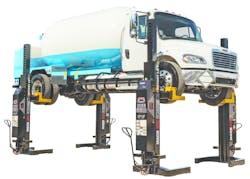Lift Safety Starts With You
Much of the familiar advice about lift safety focuses on what lift operators should do to keep themselves safe on the job. This includes:
- Inspecting the lift daily.
- Lowering the lift to its mechanical load-holding devices (locks) before going under the vehicle.
- Keeping the area around the lift clear when lifting or lowering.
- Never blocking open the lift controls.
- Not overloading the lift.
But while proper operation is important, lift safety starts well before the technician steps into the bay. Lift selection can have a significant impact on bay safety.
Selection
Whether buying a light duty two-post lift to service cars and light trucks, or a mobile column lift for heavy duty vehicles, always choose an ALI (Automotive Lift Institute)-certified lift. Lifts that wear the gold ALI-certified label have been third-party tested and certified to meet national safety and performance standards.
Even though the International Building Code and state/local regulations in all 50 states require certified lifts, the responsibility for buying and installing certified lifts lies with the customer.
It is legal to sell non-certified lifts in the U.S. Don’t just assume that a lift is safe. Do your homework. ALI maintains a database of certified lifts on its website at www.autolift.org.
Another important consideration is making sure the lift you select can properly handle the vehicles your shop will be servicing. In addition to sufficient rated load capacity, this can mean making sure a frame-engaging lift can reach the manufacturer’s recommended lifting points on vehicles, that the runways are long enough and wide enough on platform lifts, or that the lift can pick up any tandem-axle vehicles. Set your technicians up for success with equipment that can do the job.
Beyond the Basics
Next, examine each lift’s feature set. Basic features to look for include hold-to-run controls, emergency stop buttons, automatic synchronization, lockable disconnect switches and lower-to-lock controls.
For four-post and other platform lifts, automatic wheel chocks, non-skid ramp and runway surfaces, and work steps can be important. On a two-post lift, swing arm restraints, overhead shutoff bars and wheel spotting dishes or laser spotting systems are key. Heavy duty inground lifts should be equipped with a system to keep floor openings covered.
Some of the latest safety-enhancing technology for heavy duty applications can be found on mobile column lifts. Rotary Lift’s new Mach Flex powered by RedFire mobile column lifts, for example, are the first in the industry to be operated entirely by remote control, according to the company. This gives the technician the freedom to move around the vehicle while lifting to check clearances and stay alert to any issues that might not be visible from a single column.
The Mach Flex is also the first lift to have Rotary’s LockLight system built right in. It shows technicians, shop managers and anyone else in the shop, at a glance, if the lift is resting on its locks.
Lift Accessories
Accessories can make a good lift even better, and in some cases, safer. When ordering a lift, it’s a good idea to also order all the necessary adapters to properly pick up vehicles. For example, you might need stacking adapters to reach the manufacturer-recommended lifting points on a truck using a two-post lift.
Keep in mind, not all adapters are created equal. Some manufacturers’ adapters are much lighter and easier to use than others, which can be an important ergonomic consideration in keeping technicians safe on the job.
Periodically review to make sure the proper adapters are available for all the lifts in the shop. Review your lifts and adapters any time you make a change in fleet makeup, as what worked for one vehicle may not necessarily work for another. Never make or modify adapters.
Another worthwhile accessory is the support stand. These should be used to provide additional support under a vehicle any time a load may shift, such as when vehicle components are removed. Make sure there are sufficient quantities of support stands in working order in the shop.
Did you know that lift accessories are also subject to ALI certification? According to the ANSI (American National Standards Institute) standard for lift operation, inspection and maintenance, accessories should be certified at the same time as the lift itself. ALI’s certified lift directory includes listings of all accessories certified for each lift.
Shop safety is everyone’s responsibility. With some research upfront, you can set the foundation for a safe shop when choosing your next lift or updating the accessories you have now.
Doug Spiller is heavy duty product manager for Rotary Lift (www.rotarylift.com), North America’s largest and oldest lift manufacturer. The company offers a very broad line of lifts and wheel service equipment in North America.
